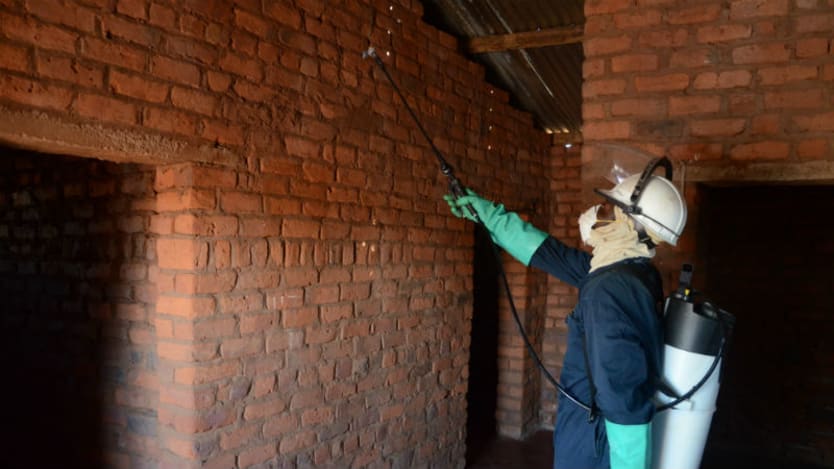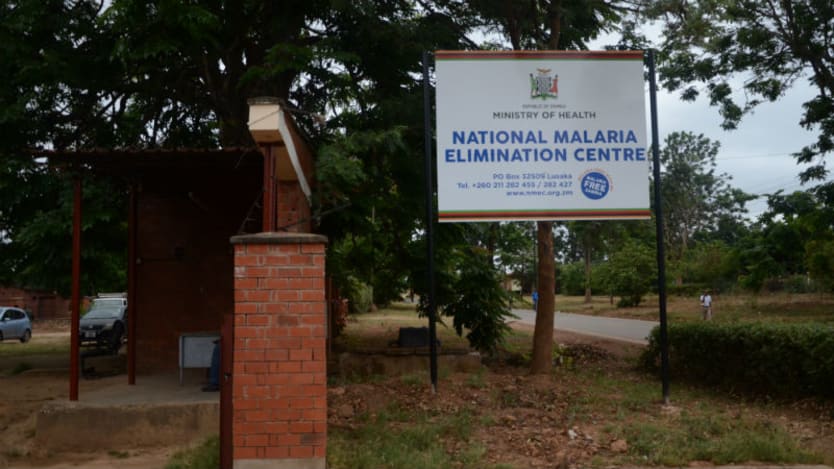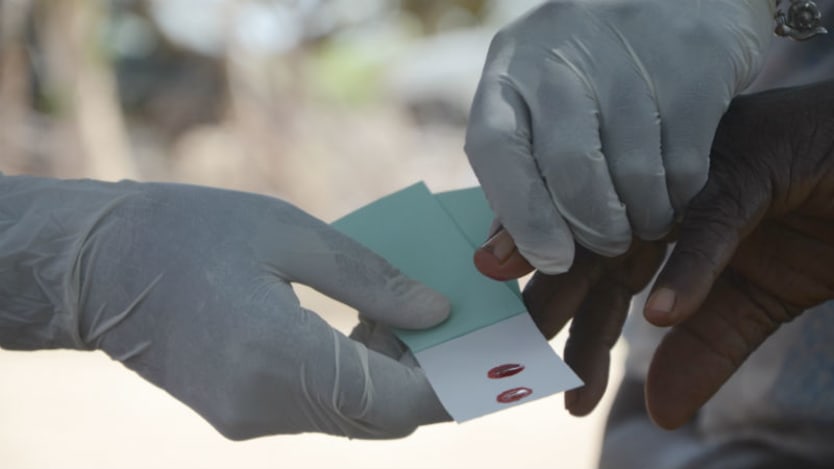
KAZINYONE, Zambia — Joba Edwards spends the night outside in a tee-shirt and shorts, with a flashlight in hand, waiting for mosquitoes to bite him. When they do, he catches the bugs by sucking through the tube on a mouth aspirator, which traps them. He then funnels the mosquitoes into a Styrofoam cup, covered with a net. He has twelve of these cups, each marked by pen with a different hour of the night. Edwards sits on a wooden stool doing this from 6 p.m. to 6 a.m., five nights per month.
The crow of the roosters and the sunrise over Kazinyone village signal the end of Edward’s shift. The cups are placed in a cooler, gathered with samples from 36 other mosquito trappers, and shipped to the capital city of Lusaka to be examined in a laboratory at the National Malaria Elimination Center, as part of research efforts to better understand the behaviors of mosquitoes in the region. Edwards is paid about $10 per shift, and given a cup of coffee to get him through the night.
Edwards is what’s called a “human landing catch.” He is collecting mosquitoes as part of a study, through Zambia’s Ministry of Health, that is identifying the prevalence of the range of species of mosquitoes in the region, as well as identifying at what point in the night they bite, among other research questions.
Kazinyone is in Zambia’s Southern Province, which is leading the country in its progress in the reduction of malaria cases. The number of confirmed malaria cases in the province has decreased 74 percent from over 159,000 cases in 2014, to over 41,000 cases in 2016.
See more related topics:
► Fight against malaria stalling and could reverse, warns 2017 World Malaria Report
► Q&A: MESA chair talks next steps in the fight against malaria
► Q&A: Pedro Alonso, director of WHO's Global Malaria Program
► Gates doubles down on malaria eradication with influential new group
Because of the great gains in reducing its malaria caseload in Southern Province, Zambia is aiming to eliminate malaria completely from the country by 2021. If Zambia were to achieve elimination, it would be one of the first countries in Africa to do so, and the only country in sub-Saharan Africa. Many have attributed its successes so far to strong leadership. If the country reaches elimination, its evidence-based, localized response could serve as an example for other countries in the region.
Africa accounts for about 90 percent of malaria cases and deaths worldwide, according to the World Health Organization. The WHO’s World Malaria Report 2017, released last week, found that malaria progress has stalled. In some countries, there has even been reversals in gains achieved at reducing the burden of malaria.
“We are not making progress. We need to get back on track,” Dr. Pedro Alonso, director of the Global Malaria Programme at WHO said in a press briefing on the report.
Despite this grim outlook, Zambia is pushing on with its ambitious strategy. In its multipronged strategy for elimination, the Zambian government, along with partner organizations, have stratified the country based on burden, so that it can tailor interventions to meet specific regional needs. In areas with a high malaria burden, the interventions are focused on control of the disease. For lower-burden areas, the interventions have another layer, aimed at wiping out the parasite entirely from the population. But as the country moves towards its goal of elimination, there are barriers that stand in the way, including border transmissions and securing enough funding.
The Zambian government has been praised in the global health community for the high priority it is paying to fighting malaria.
“Zambia is a wonderful example of country ownership and country leadership in the fight against malaria” said Alonso. “Whether they will actually be able to achieve full elimination or not, remains to be seen.”
Tailored interventions
In Zambia, the number of deaths from malaria have decreased by 43 percent from over 3,200 in 2014, to under 1900 in 2016, according to the Ministry of Health.
The government of Zambia is leading its elimination efforts through its National Malaria Elimination Center. The center became its own national directorate in April, when President Edgar Lungu launched the government’s National Malaria Elimination Strategy. Its main partners in these efforts include the Global Fund to Fight AIDS, Tuberculosis and Malaria, United States Agency for International Development, U.S. President's Malaria Initiative, Centers for Disease Control and Prevention, Bill & Melinda Gates Foundation, PATH’s Malaria Control and Evaluation Partnership in Africa and Program for the Advancement of Malaria Outcomes, WHO and United Nations Children's Fund.
A key part of Zambia’s national malaria elimination strategy is tailoring the malaria interventions, depending on the level of the malaria burden. This is determined by health facility catchment areas. In areas that have more than 50 cases of malaria per 1,000, the focus of interventions is on reducing that burden and strengthening the health system. This is done through distributing long-lasting insecticide-treated mosquito nets, providing rapid diagnostic tests and treatment with artemisinin-based combination therapies, spraying the walls of homes with insecticides, and providing preventative treatment for pregnant women, among other interventions.

In areas with a moderate level of transmission, the elimination efforts include the use of mass drug administration, which includes treating certain populations whether or not they have been tested for malaria. This intervention is aimed at preventing someone without symptoms from being a source of transmission for the rest of the community. Mass drug administration is used in areas where there are between 50 to 500 cases per 1,000 in the previous year, in combination with very high vector control.
The malaria mass drug administration method has likely contributed to a 93 percent reduction in malaria in children in Southern Province, according to PATH’s Malaria Control and Elimination Partnership in Africa, or MACEPA.
For the areas that have fewer than 50 cases of malaria per 1,000, the focus of the interventions are more targeted to further reduce the amount of cases. The same interventions are used, but another layer is added. In these areas, the goal is to clear the parasite from the entire community. Instead of targeting specific populations, such as young children and pregnant women, the target population becomes everyone.
“In low burden areas, countries devise a strategy that often depends on how close an area is to elimination,” said Melanie Luick-Martins, office director for Health, Population, Nutrition, and HIV at USAID Zambia. “Universal [insecticide treated nets] coverage still applies, but [indoor residual spraying] becomes more focal, hitting hot spots which are identified by surveillance data.”
In its elimination strategy, one of the first step is improving the quality of data, said Duncan Earle, director for country programs of MACEPA. Nationwide, every Monday morning, information officers at 684 health facilities, which is about one-third of the clinics across the country, submit responses to 18 questions on their cell phones, which include suspected and confirmed cases of malaria, the type of treatment dispensed, the test kits and treatment remaining on the shelf, as well as the travel history of the patient. The data is sent to a central server, where it is accessed by health officials at the national level who use it for decision-making.
PATH is also partnering with Tableau and other tech companies to sift through this data to create maps which can help predict where transmission outbreaks are likely.
If Zambia reaches zero cases, it will have to maintain no locally-transmitted cases for three consecutive years before WHO will declare the disease is eliminated.
Community health workers and contact-tracing
Pivotal to the elimination strategy is the use of community health workers.Thirty-eight-year-old Tomaida Phiri is one of them, serving communities in Eastern Province. Beyond her duties as a mother of seven, and a farmer, she is also a community health worker. She is on call, around the clock, available for visits from the over 780 patients that depend on her in seven surrounding villages.
Her home has become her clinic. She tests patients for malaria and provides positive cases with treatment. For more severe cases, she refers them to the local clinic. When she runs out of supplies, she walks about four hours to the nearest clinic to restock on medicines and anything else she needs. She typically gets around 50 patients per week. Her work as a community health worker has also improved the health in her own home.
“Previously, on a weekly basis someone in my house would get malaria,” she said. “I used to spend a lot of money taking my kids to the clinic and I had to borrow money from the neighbors for transport to the clinic.”

Using community health workers helps to ease the workloads on the local facilities, said Earle of PATH. When the easily-treatable cases are managed at the community level, it leaves the facilities to handle more complicated health needs. Eventually, the national goal is to have one community health worker providing health care for every 500 people.
In 16 sites in Southern Province, these community health workers have an additional layer of responsibility. After a person is tested positive for malaria, and is treated, the health worker follows up with them several times. Neighboring homes in a radius of 460 feet are also tested.
The four household visits are done as part of the CoRE study through the Ministry of Health and the National Malaria Elimination Center, in partnership with PATH. The aim is to compare case follow-up with the frontline artemisinin-based combination therapy Artemether-Lumefantrine versus with the drug DHAp. Lab work is to done to determine if re-infection is occurring and when, and to see how much infection is missed with the rapid diagnostic test. The study is aimed at identifying which method is better at accelerating areas to very low transmission and even eliminating transmissions.
Community health workers such as Phiri are unpaid. While the use of community health workers has been a key part of Zambia’s malaria strategy, in the long term, it is hard to run a sustainable program with unpaid volunteers, said Luick-Martins.
Border transmission
Despite Zambia’s greatest efforts, it can’t achieve elimination without participation from its neighbors. To the country’s northeast and west, Zambia is bordering countries that have high malaria burdens, including the Democratic Republic of the Congo, Malawi and Mozambique. As a result, in the areas that Zambia touches those countries, there is also a high malaria burden. Alternatively, Zambia is a threat to its neighbors to the south, including South Africa, Namibia, Botswana and Swaziland, which have a lower malaria burden.
To combat this, eight countries in southern Africa — Zambia, Angola, Zimbabwe, Mozambique, Namibia, Botswana, Swaziland, Lesotho and South Africa — have come together to create an alliance called the Elimination 8, aimed at facilitating collaboration on malaria efforts across borders.
The alliance has established a regional malaria surveillance database, a regional diagnosis program, which allows the E8 countries to pool infrastructure and technical expertise, and is building a network of border clinics.
Funding gaps
Another challenge to achieving elimination is funding. According to the WHO report, global malaria funding has plateaued since 2010. The countries with the largest malaria burdens have seen a reduction in per capita investments in these countries over the past few years, Dr Abdisalan Noor, team leader, Surveillance, Global Malaria Programme at WHO, said during a call with reporters.
If Zambia wants to achieve elimination, it will have to maintain funding levels plus increase funding by some 50 percent more, said Earle. But the government has not yet secured these funds. The national elimination strategy comes to about $120 million per year. This is compared to the current average cost of controlling malaria, which is about $80 million per year, he said.
The hope is that high expenditures upfront for elimination efforts will lead to savings in the future and build up health systems along the way, said Dr. Elizabeth Chizema, director of the National Malaria Elimination Center.
“We can’t afford to continue with control, because we will continue at that level of spending forever,” she said.
There is a small set of key international malaria funders, said Alonso of WHO. According to the WHO report released last week, the U.S was the largest international source of malaria financing in 2016, providing 38 percent of all funds, followed by the United Kingdom and other international donors, including France, Germany and Japan.
In the U.S. Administration’s fiscal year 2017 budget request to Congress, an increase was requested for malaria. This included work with partners to accelerate elimination efforts in at least two countries, including Cambodia and Zambia.
Support from international partners is less of a concern, said Alonso. Getting countries with high malaria burdens to increase their domestic spending on fighting malaria is key.
“We need to retain the strong engagement from international partners and increase the contribution of countries themselves,” he said.
Zambia has increased its domestic funding commitment by 19 percent from $24 million in 2014 to $28.5 million in 2017, according to Earle. For instance, the government has allocated $5.8 million this year for indoor residual spraying of homes. In the past, the funding for this largely came from partner support, said Chizema. According to WHO’s World Malaria Report, Zambia has the highest level of domestic funding per person at risk of malaria in East and Southern Africa.
Moving forward, one of the ways that Zambia is aiming to increase its domestic funds for malaria is through a “sin tax,” or a tax on alcohol, tobacco and junk food, as well as a national social health insurance scheme, Dr. Chitalu Chilufya, minister of health for Zambia told a group of reporters.
As the country moves closer to 2021, sustaining investment will be crucial to the country reaching its goals, as well as maintaining the progress it’s achieved.
“When funding is removed, especially with malaria, you see a really rapid return to very high levels of infections and deaths,” said Dr. Carrie Nielsen, PMI resident advisor for Zambia.
Editor’s note: Washington Global Health Alliance and Malaria No More facilitated Devex's travel and logistics for this reporting. However, Devex maintains full editorial control of the content.








